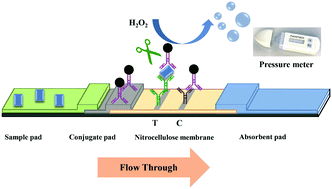Lateral flow assay with pressure meter readout for rapid point-of-care detection of disease-associated protein†
Abstract
Paper-based assays such as lateral flow assays are good candidates for portable diagnostics owing to their user-friendly format and low cost. In terms of analytical detection, lateral flow assays usually require dedicated instruments to obtain quantitative results. Here we demonstrate a lateral flow assay with handheld pressure meter readout for the rapid detection of disease-related protein with high sensitivity and selectivity. Based on the pressure change produced by the catalytic reaction of Pt nanoparticles related to the concentration of the target, a quantitative reaction platform was established. During the lateral flow assay, the Pt nanoparticles are aggregated in the test line to form a gray band by biomolecular recognition and finally convert the recognition signal into highly sensitive pressure readout for quantitative analysis. Without sophisticated instrumentation and complicated operations, the whole detection process can be completed within 20 minutes. The limit of detection for myoglobin (2.9 ng mL−1 in diluted serum samples) meets the requirements of clinical monitoring. With the advantages of low cost, ease of operation, high sensitivity and selectivity, the method represents a versatile platform for point-of-care testing of disease biomarkers.



 Please wait while we load your content...
Please wait while we load your content...